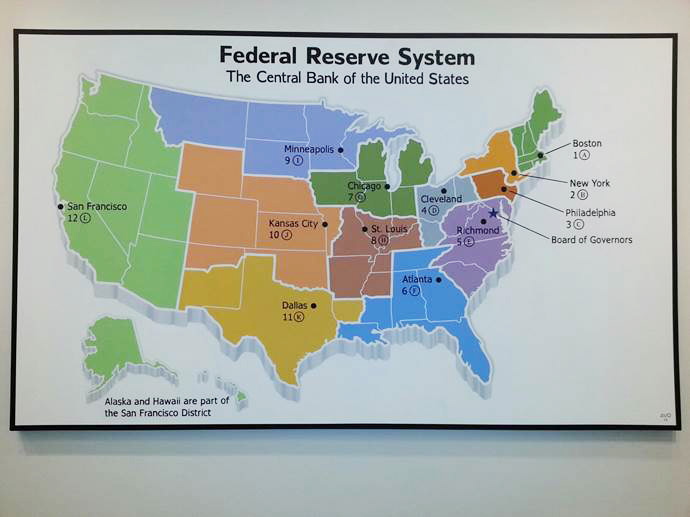Bank Regulation In The Post-Financial Crisis World
A Stimulating Lunch And Tour of The Federal Reserve Bank of San Francisco
 A sell-out crowd of FWSF members joined a distinguished group of Federal Reserve Bank regulators on July 17, 2014 to learn more about the complex world of bank supervision from Director Summer Cole, followed by an invigorating tour of the Fed’s collection of rare currency led by FWSF member Marty Tunnell.
A sell-out crowd of FWSF members joined a distinguished group of Federal Reserve Bank regulators on July 17, 2014 to learn more about the complex world of bank supervision from Director Summer Cole, followed by an invigorating tour of the Fed’s collection of rare currency led by FWSF member Marty Tunnell.
Summer Cole, a Director of the Federal Reserve Bank of San Francisco, shared her insights into the evolution of large bank supervision since the financial collapse. Summer recalled the days of working around the clock—taking catnaps on cots in conference rooms—during the hectic crisis itself. As a result of the first wave of stress tests, in 2009 ten banks were required to raise a combined $75 billion in capital within 6 months.
Summer described in detail how the Dodd-Frank Act and other post-crisis regulations have led to a complex regulatory scheme intended to safeguard against another financial collapse even in economic downturns. Whereas before the crisis, the Fed’s supervision of banks was firm specific, with limited data collection and analysis that resulted in backward-looking assessment, since the crisis the Fed is focused on the financial system more broadly, with extensive data collection and analysis, and forward-looking assessments. The goal was not only to increase capital but to restore confidence in the financial institutions.
Dodd-Frank mandated stress testing of financial institutions. Stress testing employs scrutinizing capital levels of financial institutions, with greater levels of scrutiny applied depending on the size of the institution’s assets. The eight largest banks are subject to the most requirements, including long-term debt requirements, stressed liquidity buffers, certain capital requirements, countercyclical capital buffers, capital plan submissions, single counter party credit limits, and more. If the Fed finds that a bank has insufficient capital or deficient practices, it can require the bank to undergo capital plan remediation or remedy other weaknesses.
In 2013 the Fed began conducting stress tests pursuant to Dodd-Frank. Whereas earlier stress tests were quantitative in focus, beginning in 2013 qualitative stress testing looks at assumptions in methodologies and thus imposes a higher bar on banks. Four institutions did not pass the qualitative tests conducted, and the results were felt on Wall Street. While Summer cannot predict the future, it seemed clear that banking regulation will never be the same.
The Federal Reserve Bank tour, led by FWSF member Marty Tunnell, was a fascinating inside look at the high-security world of cash – millions of it. Participants witnessed how currency was counted and stored, the technology used to deter and detect counterfeiting, and the security measures employed to keep if safe. The stark hallways of the bank were lined with cameras. Yet, the tour atmosphere was light and informative as everyone gazed upon stacks of money handled by busy workers with unparalleled efficiency. Their speed and focus displayed the tremendous coordination and work required to manage the physical flow of cash.
The tour was concluded with a visit to a gallery displaying a large collection of rare historic notes, including the extremely rare and valuable 1882 $10,000 Gold Certificate (a bill that was redeemable in gold coin until 1933), and a presentation on the history of money. Each participant left with a new understanding and a free packet of shredded bills.
 Marty Tunnell, a Senior Supervisory Analyst at the Federal Reserve Bank, drew from a wealth of experience and a deep knowledge of the bank’s operations. For the second year in a row, she has provided this unique opportunity to FWSF members. Thanks to Marty’s enthusiasm, her charming anecdotes and the fun facts she provided, the tour was as entertaining as it was educational.
Marty Tunnell, a Senior Supervisory Analyst at the Federal Reserve Bank, drew from a wealth of experience and a deep knowledge of the bank’s operations. For the second year in a row, she has provided this unique opportunity to FWSF members. Thanks to Marty’s enthusiasm, her charming anecdotes and the fun facts she provided, the tour was as entertaining as it was educational.









